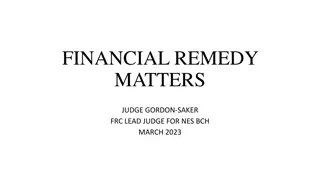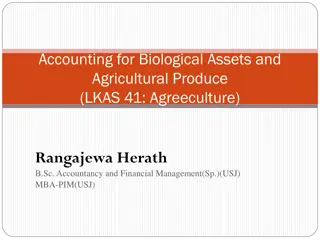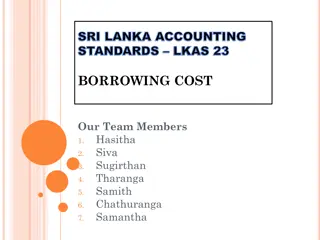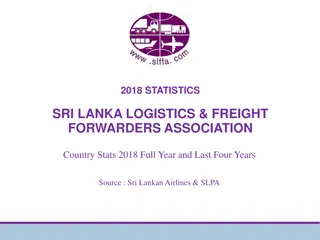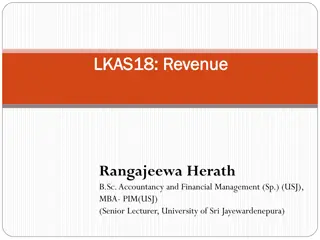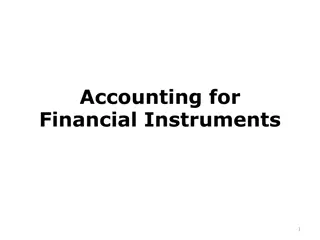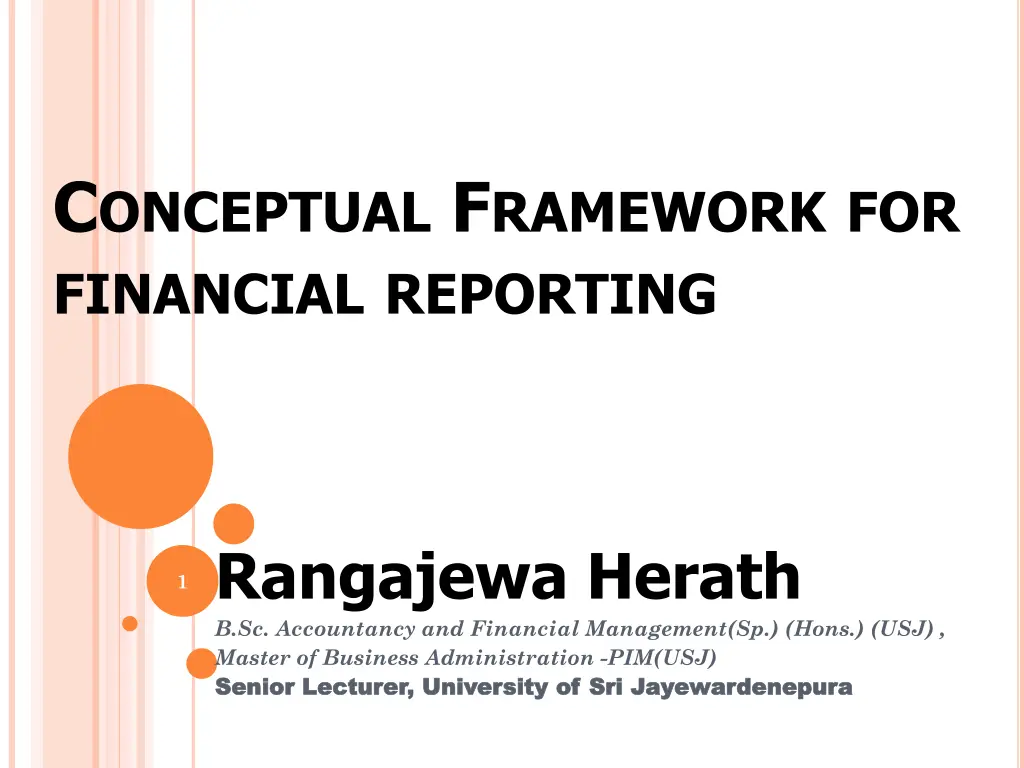
Conceptual Framework for Financial Reporting and Its Components
Explore the conceptual framework for financial reporting developed by Rangajewa Herath, outlining the objective, underlying assumptions, qualitative characteristics, and relevance in providing useful financial information to stakeholders.
Download Presentation

Please find below an Image/Link to download the presentation.
The content on the website is provided AS IS for your information and personal use only. It may not be sold, licensed, or shared on other websites without obtaining consent from the author. If you encounter any issues during the download, it is possible that the publisher has removed the file from their server.
You are allowed to download the files provided on this website for personal or commercial use, subject to the condition that they are used lawfully. All files are the property of their respective owners.
The content on the website is provided AS IS for your information and personal use only. It may not be sold, licensed, or shared on other websites without obtaining consent from the author.
E N D
Presentation Transcript
CONCEPTUAL FRAMEWORK FOR FINANCIAL REPORTING Rangajewa Herath B.Sc. Accountancy and Financial Management(Sp.) (Hons.) (USJ) , Master of Business Administration -PIM(USJ) Senior Lecturer, University of Sri Jayewardenepura Senior Lecturer, University of Sri Jayewardenepura 1
THE STRUCTUREAND COMPONENTSOFTHE CONCEPTUAL FRAMEWORKOF FINANCIAL REPORTING The objective of financial reporting; Underlying Assumption The qualitative characteristics of useful financial information; The definition, recognition and measurement of the elements from which financial statements are constructed; and concepts of capital and capital maintenance. 2
THEOBJECTIVEOFGENERALPURPOSE FINANCIALREPORTING To provide financial information about the reporting entity that is useful to existing and potential investors, lenders and other creditors in making decisions about providing resources to the entity. 3
UNDERLYING ASSUMPTION Going Concern The financial statements are normally prepared on the assumption that an entity is a going concern and will continue in operation for the foreseeable future. Hence, it is assumed that the entity has neither the intention nor the need to liquidate or curtail materially the scale of its operations; if such an intention or need exists, the financial statements may have to be prepared on a different basis and, if so, the basis used is disclosed. 4
QUALITATIVECHARACTERISTICS Relevance Fundamental Faithful representation Qualitative characteristics Comparability Timeliness Enhancing Verifiability Understandability5
RELEVANCE Relevant financial information is capable of making a difference in the decisions made by users. Information may be capable of making a difference in a decision even if some users choose not to take advantage of it or are already aware of it from other sources. 6
RELEVANCECONT. Financial information has predictive value if it can be used as an input to processes employed by users to predict future outcomes. Financial information has confirmatory value if it provides feedback about (confirms or changes) previous evaluations. 7
FAITHFULLREPRESENTATION To be useful, financial information must not only represent relevant phenomena, but it must also faithfully represent the phenomena that it purports to represent. To be a perfectly faithful representation, a depiction would have three characteristics : complete, neutral and free from error. 8
FAITHFULLREPRESENTATION Complete - all information necessary for a user to understand the phenomenon being depicted, including all necessary descriptions and explanations. Neutral - without bias in the selection or presentation of financial information. Free from error - there are no errors or omissions in the description of the phenomenon, and the process used to produce the reported information has been selected and applied with no errors in the process. 9
COMPARABILITY Comparability - information about a reporting entity is more useful if it can be compared with similar information about other entities and with similar information about the same entity for another period or another date. 10
VERIFIABILITY Verifiability - Verifiability means that different knowledgeable and independent observers could reach consensus, although not necessarily complete agreement, that a particular depiction is a faithful representation. Verification can be direct or indirect. Direct verification means verifying an amount or other representation through direct observation. Indirect verification means checking the inputs to a model, formula or other technique and recalculating the 11 outputs using the same methodology.
TIMELINESS Timeliness means having information available to decision- makers in time to be capable of influencing their decisions. Generally, the older the information is the less useful it is. However, some information may continue to be timely long after the end of a reporting period because, for example, some users may need to identify and assess trends. 12
UNDERSTANDABILITY Classifying, characterizing and presenting information clearly and concisely makes it understandable. Financial reports are prepared for users who have a reasonable knowledge of business and economic activities and who review and analyse the information diligently. 13
ELEMENTSOF FINANCIAL STATEMENTS Asset Liability Equity Income Expenses 14
ASSETS An asset is a resource controlled by the entity as a result of past events and from which future economic benefits are expected to flow to the entity. 15
LIABILITY A liability is a present obligation of the entity arising from past events, the settlement of which is expected to result in an outflow from the entity of resources embodying economic benefits.. 16
EQUITY Equity is the residual interest in the assets of the entity after deducting all its liabilities. 17
INCOME Income is increases in economic benefits during the accounting period in the form of inflows or enhancements of assets or decreases of liabilities that result in increases in equity, other than those relating to contributions from equity participants. 18
EXPENSE Expenses are decreases in economic benefits during the accounting period in the form of outflows or depletions of assets or incurrences of liabilities that result in decreases in equity, other than those relating to distributions to equity participants. 19
RECOGNITIONOF ELEMENTSIN THE FINANCIAL STATEMENTS Recognition is the process of incorporating in the Statement of Financial Position or Statement of Comprehensive Income an item that meets: The definition of an element of the financial statements and The criteria for recognition; It is probable that any future economic benefit associated with the item will flow to or from an entity. (The probability of future economic benefit) The item has a cost or value that can be measured reliably. (Reliability of 20 measurement)
MEASUREMENTOFTHEELEMENTSOF FINANCIALSTATEMENTS Historical cost Current cost Realizable ( settlement) value Present value 21
HISTORICALCOST Assets are recorded at the amount of cash or cash equivalents paid or the fair value of the consideration given to acquire them at the time of their acquisition. Liabilities are recorded at the amount of proceeds received in exchange for the obligation, or in some circumstances (for example, income taxes), at the amounts of cash or cash equivalents expected to be paid to satisfy the liability in the normal course of business. 22
CURRENTCOST Assets are carried at the amount of cash or cash equivalents that would have to be paid if the same or an equivalent asset was acquired currently. Liabilities undiscounted amount of cash or cash equivalents that would be required to settle the obligation currently. are carried at the 23
REALIZABLE ( SETTLEMENT) VALUE Assets are carried at the amount of cash or cash equivalents that could currently be obtained by selling the asset in an orderly disposal. Liabilities are carried at their settlement values; that is, the undiscounted amounts of cash or cash equivalents expected to be paid to satisfy the liabilities in the normal course of business. 24
PRESENT VALUE Assets are carried at the present discounted value of the future net cash inflows that the item is expected to generate in the normal course of business. Liabilities are carried at the present discounted value of the future net cash outflows that are expected to be required to settle the liabilities in the normal course of business. 25
CONCEPTSOFCAPITAL A financial concept of capital is adopted by most entities in preparing their financial statements. Under a financial concept of capital, such as invested money or invested purchasing power, capital is synonymous with the net assets or equity of the entity. Under a physical concept of capital, such as operating capability, capital is regarded as the productive capacity of the entity based on, for example, units of output per day. 26
CONCEPTSOFCAPITALMAINTENANCEAND THEDETERMINATIONOFPROFIT Financial capital maintenance. Under this concept a profit is earned only if the financial (or money) amount of the net assets at the end of the period exceeds the financial (or money) amount of net assets at the beginning of the period, after excluding any distributions to, and contributions from, owners during the period. Financial capital maintenance can be measured in either nominal monetary units or units of constant purchasing power. 27
CONCEPTSOFCAPITALMAINTENANCEAND THEDETERMINATIONOFPROFIT Physical capital maintenance. Under this concept a profit is earned only if the physical productive capacity (or operating capability) of the entity (or the resources or funds needed to achieve that capacity) at the end of the period exceeds the physical productive capacity at the beginning of the period, after excluding any distributions to, and contributions from, owners during the period. 28
PRESENTATIONOF FINANCIAL STATEMENTS (LKAS 01) Rangajewa Herath B.Sc. Accountancy and Financial Management(Sp.) (Hons.) (USJ) , Master of Business Administration -PIM(USJ) 29
LKAS 1 - Presentation of Financial Statements prescribes the basis for the presentation of general purpose financial statements for public limited companies. It sets out the overall requirements for presentation of financial statements, guideline for structure 30
GENERALPURPOSEFINANCIALSTATEMENTS General Purpose Financial Statements are the financial statements those intended to meet the needs of users who are not in a position to require an entity to require an entity to prepare reports tailored to their particular information needs. 31
OBJECTIVESOF FINANCIAL STATEMENTS The objective of financial statements is to provide information about the financial position, financial performance and cash flows of an entity to wide range of users in making economic decisions. 32
FINANCIALSTATEMENTSPROVIDES INFORMATIONABOUTANENTITY S Assets; Liabilities; Equity; Income and expenses; Contribution from and distribution to owners in their capacity of owners; and Cash flows 33
COMPLETE SETOF FINANCIAL STATEMENTS The components of a complete set of financial statements are; Statement of Financial Position Statement of profit or loss and other comprehensive Income Statement of Changes in Equity Statement of Cash Flows Notes, including a summary of significant accounting policies and other explanatory information A statement of financial position at the beginning of the earliest comparative 34 period when an entity applies an accounting policy retrospectively or makes a retrospective restatement of items in its financial statements.
STATEMENTOF PROFITOR LOSSAND OTHER COMPREHENSIVE INCOME Other comprehensive income comprises items of income and expenses that are not recognized in profit or loss as required or permitted by other SLFRS. Profit or loss is the total income less expenses excluding the components of other comprehensive income. 35
OTHER COMPREHENSIVE INCOME Changes in revaluation surplus. Gains or losses arising from translating the Financial Statements of a foreign operation. Gains or losses on re-measuring available-for-sale financial assets. The effective portion of gains and losses on hedging instruments in a cash flow hedges. 36 Actuarial gains and losses on defined benefit plans.
TOTAL COMPREHENSIVE INCOME The change in equity during a period resulting from transactions and other events, other than those changes resulting from transactions with owners in their capacity as owners. Total Comprehensive = Profit or Loss + OCI Income 37
GOINGCONCERN When preparing financial statements, management shall make an assessment of the entity s ability to continue as going concern. An entity should prepare the financial statements on going concern basis unless the management either intends to liquidate the business or cease trading, or has no realistic alternative but to do so. 38
ACCRUAL BASISOF ACCOUNTING An entity should prepare its financial statements, except for the cash flow information, on accrual basis. 39
MATERIALITYAND AGGREGATION Each material class of similar items should be separately presented. Immaterial items can be aggregated and presented according to either their nature or function. 40
OFFSETTING An entity shall not offset assets and liabilities or income and expenses, unless required or permitted by an SLFRS. 41
COMPARATIVE INFORMATION An entity should disclose comparative information in respect of the previous period for all amounts reported in the current period s Financial Statements. 42
ASSETSARERESOURCESCONTROLLEDBY THEBUSINESSASARESULTOFPAST EVENTOFWHICHFUTUREECONOMIC BENEFITSAREEXPECTEDTOFLOWTO THEENTITY. 43





